|
|
| Разместил (Author): |
SergUA6  |
| Авторские права |
© http://www.radioscanner.ru |
|
|
Текст
|
SA - how to work with OFDM module.
Several practical examples.
After version 6.1.0.5 and article SA OFDM module, constellations in channels, we received several letters with questions about how to use OFDM module and what are practical possibilities of constellations in the channels.
Even taking into account those difficulties, which have been described in previous article, SA OFDM module represents powerful tool. Operation with this tool we will be considered more detailed in this article.
Let's take DAB signal. This signal is interesting, because the quantity of it's channels is extremely great. And attempt to "charge" SA on searches of a correlative triangle with the lower limit MinBr=20 without any measurements at all, can cause very long calculations(20-30 hours and more).
Analysis of any signal is the complex task, and it is necessary, if it is possible, to use all arsenal of resources and tools which is accessible, and OFDM in this sense is not an exception Thus, the preliminary classical analysis can reduce the time very strongly. The classical analysis can help us with definition of rough boundaries of parameters, which should be used as start customizations for OFDM module.
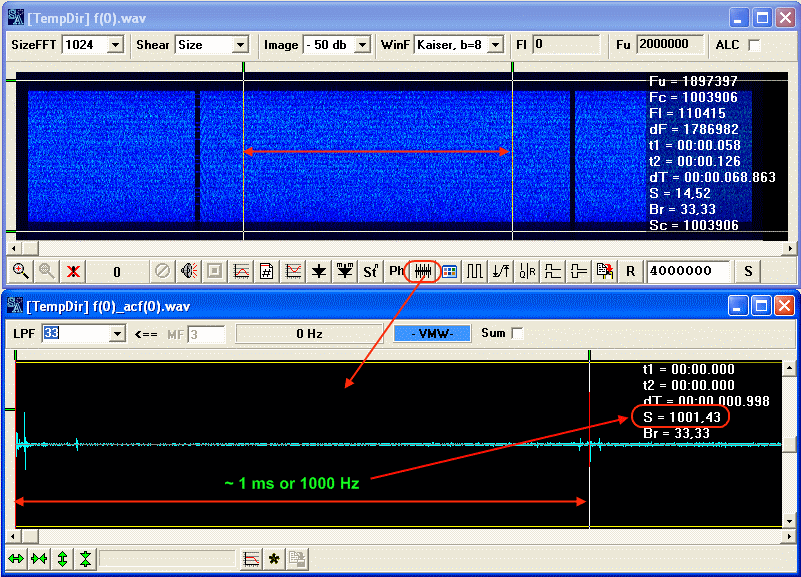
ACF, in this case it very bright, it gives high bound of Baud Rate at level of ~1000 Hz, it can't be above this value, even theoretically. So, It is already possible to set approximately boundaries as MaxBr = 1000 and MinBr = 500. Why THE low bound is selected as MaxBr/2? It is only an example, it's very rough. When ACF is bright and obvious and does not call doubts, it gives an approximate frequency spacing of a grid/net of channels, and speed of manipulation can be only below this spacing/rating. Speed, which is lesser then spacing/rating in two times, means that channels have complete partition on the spectrum. With this signal it is not so, and the lower bound is certainly strongly redundant. For OFDM with CP, channels are rather easily distinguishable, even when relation of a frequency spacing and speed of manipulation Shift/Br is equal to 1.5-1.3 times. It is difficult to say that in this signal frequencies are easily distinguishable, therefore, the lower bound can be installed on 750 Hz. Already at such parameters in OFDM module, searches of a correlative triangle will occupy approximately 2-3 hours. Is there any other way?
Yes there is.
It is possible, and it is necessary to take a maximum from the classical analysis, continuing specification of boundaries of expected speed of manipulation. The method, which was described in The classical analysis of OFDM signals.. article, gives approximate value of clock frequency in 801-802 Hz. Although, everything is described in the article "The classical analysis of OFDM signals", let's repeat everything step by step.
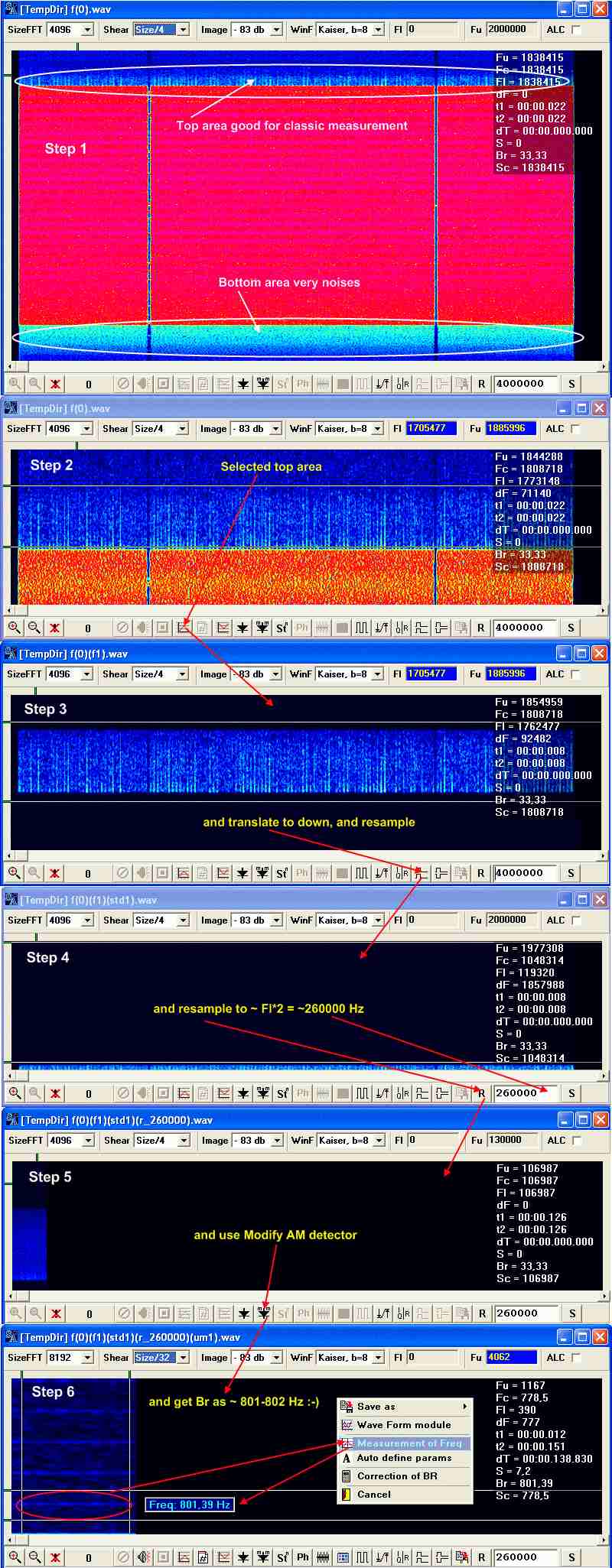
To avoid any mistakes, let's take an interval MXBr= 804 and MinBr=800. SA OFDM Module will make calculations with such settings within 2-4 minutes as a maximum.
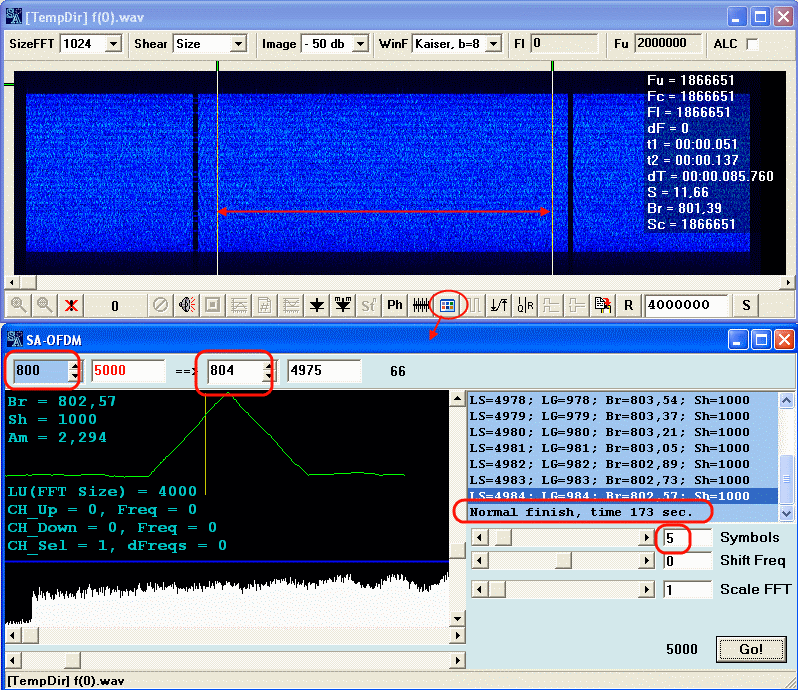
In reality, to set up the boundaries, we only need manipulation speed, an example with ACF is inserted only with the purpose, to show, that if it is not possible to get reliable value of clock frequency, then as variant, we may use results from ACF, but with more rough result of course.
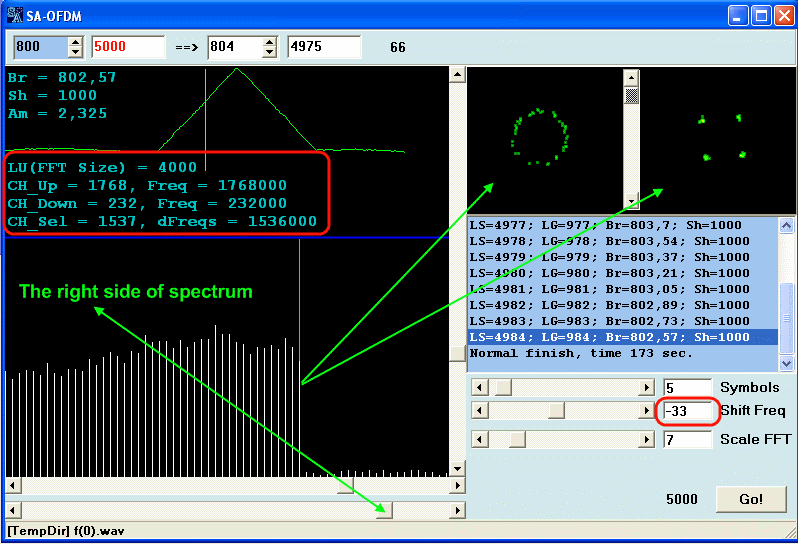
We can only suppose what is manipulation in the channels (remember SA OFDM module, constellations in channels!). Constellations in the channels are pi/DQPSK or PSK-4(QPSK), we can't to say more exactly yet.
Generally, the quantity of channels does not play a special role, speed of calculations is influenced exclusively by relation of sampling rate to speed of manipulation of researched signal Fd/Br. In case, ifthis value is behind of 1000-1500 limits, time of calculations is increasing very sharply and non-linear. Therefore, a choice of optimal and better low value of sampling rate, at searches of a correlative triangle is the very important factor.
The next and very interesting signal is OFDM-59 . It is taken from the resource http://www.signals.taunus.de/DIG_intro.htm
There is no any difficulties with definition of parameters of this signal, but initial sampling rate 11025 Hz is obviously not correct, it should be reduced to 8000 Hz value.
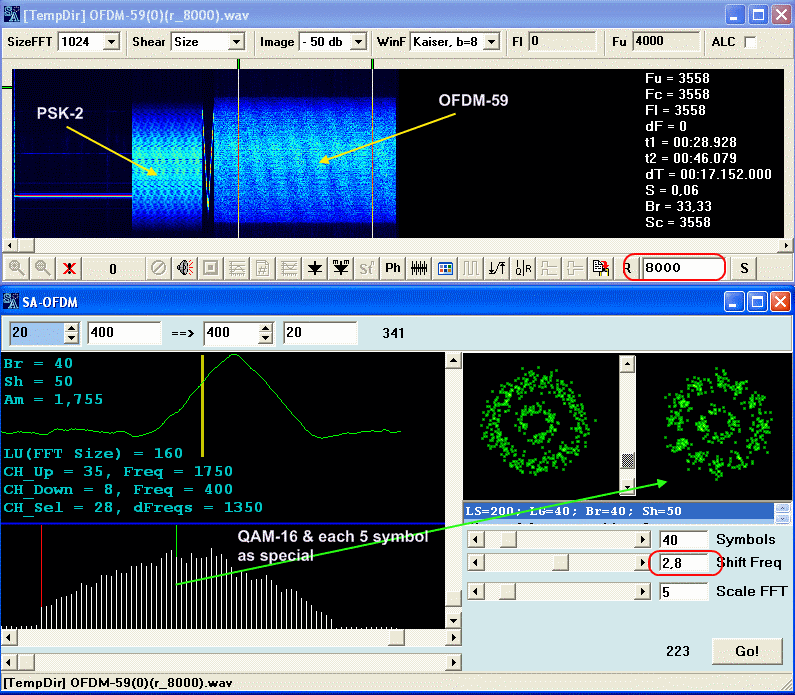
Rare, but nevertheless, a real case, when the relative constellation authentically enough says, that manipulation mode in channels - is QAM-16. Symbol-by-symbol moving on the signal allows to detect one more feature: every fifth symbol is auxiliary/service, an amplitude is same in all channels. Most likely these auxiliary/service symbols are intended for fast customization/fine tuning of an equalizer of demodulator, because QAM modulation is very sensitive to amplitude-phase distortions and their constant correction is required.
The next signal is WinDrm
Working with analysis technique, it is possible to calculate parameters of this signal almost precisely, that allows to receive convincing absolute constellations in any channel. As it is easy to notice, QAM-64 is used with various service "borders", which are intended for various systems of an auto-regulation, positioning of constellations precisely on axes, etc.
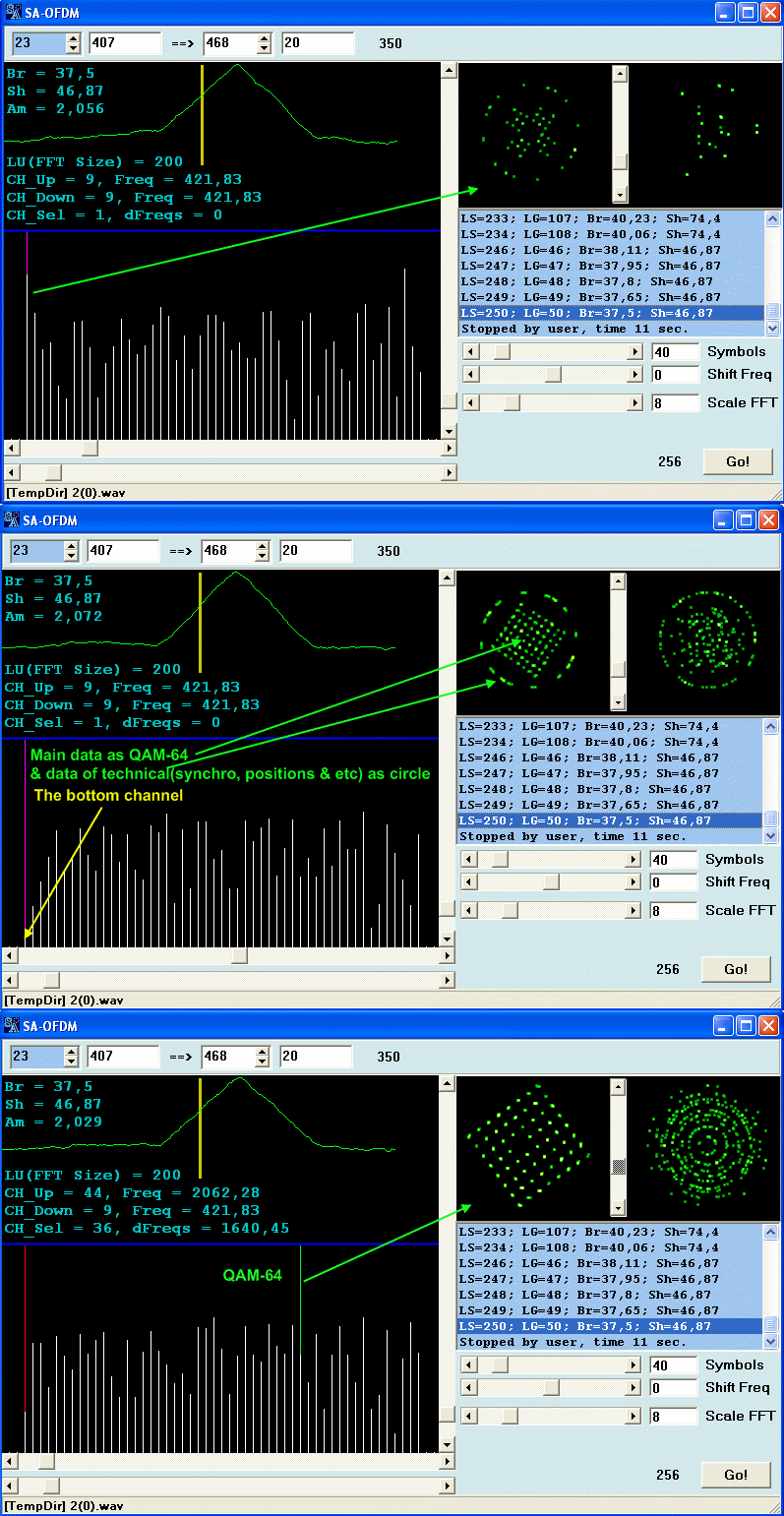
And the last signal, which we will consider in full (as the first signal) is Q15X25.
There are some reasons for it:
- in the first, manipulation in channels is wrongly defined (not by us) as relative, actually there is an absolute PSK-4 (QPSK);
- in the second, for search of a correlative triangle it is necessary to try a little;
- in the third, the record possesses features which we will try to explain.
The signal is short enough, this fact already causes some difficults, as on short records the data for for getting of a convincing correlative triangle can simply be not sufficent that purely occurs.
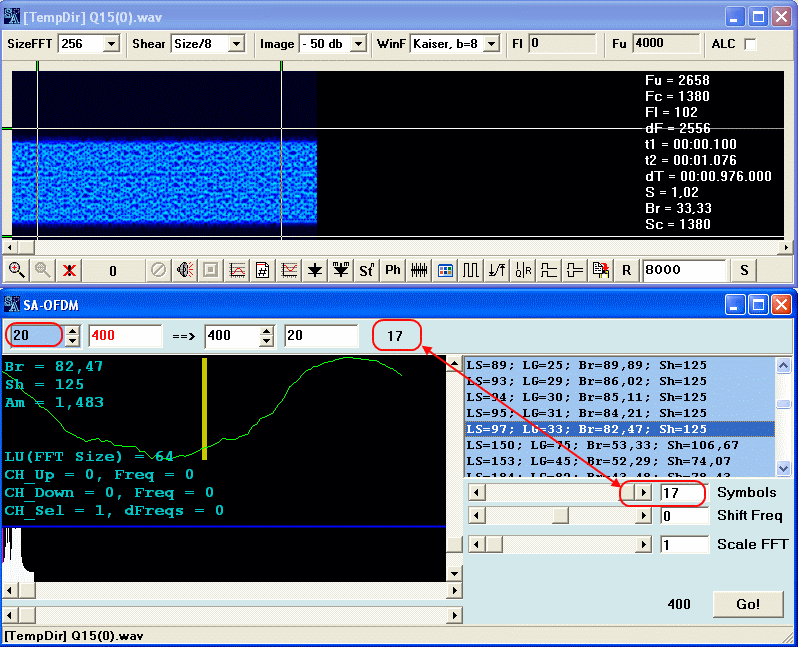
The program stops on parameters "LS=97, LG=33, Br=82.47, Sh=125", and continues to search for the next ones. There is nothing surprising in it, but as a result the program does not find a convincing triangle. One of the reasons can be (and as a rule it happens) insufficient quantity of material for the analysis, in this case, we have only 17 symbols, which can take part in calculations.
There is the one thin moment: if speed of manipulation is low, then the symbol is long enough, and it can be enough to have 10 symbols for reliable calculation. In case, if speed of manipulation is high (relatively high of course), then even 30 symbols can be not sufficient, as the symbols are short.
Manipulating by MinBr parameter, at the expense of it’s increasing, we can receive more symbols for calculations on the short signals. And in this signal we have to use this ability, because, if manipulation speed would be really around 20-30 Hertz, then 17 symbols would be enough. Let's increase the boundary of MinBr untill the value, at which we will have 40 symbols, and start calculation again.
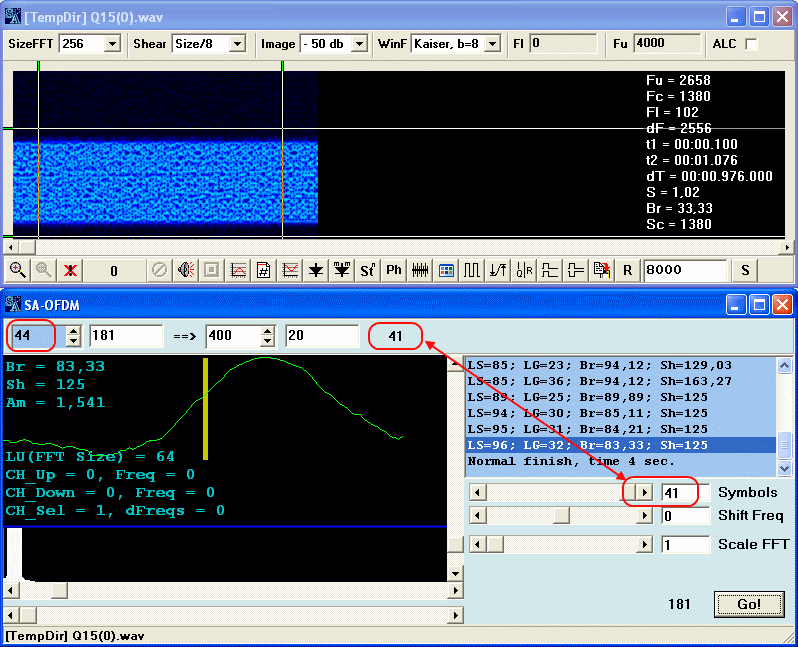
Now the program unmistakably finds, which is demanded, because now we got enough material for calculations. This isn't a trick, it is necessary to know and understand, that default parameters in OFDM module are not always optimal. And even if SA hadn't find anything, it does not mean that the program badly searching, in most cases, it means that "it was badly explained to SA" where it is necessary to search.:)
One more interesting moment: if you are trying now to walk symbol-by-symbol on fragment of the record to receive constellation, you will hardly make more than 5 steps, and thus it won't be possible to show clear constellations. The problem is that Symbols slider is installed at level of 40 symbols, it means that space in the record with length in 40 symbols is always reserved for correct calculation of the triangle, as it is always displayed. And if you move on one symbol by symbol-by-symbol moving, then together with it the main structure in 40 symbols(which is always located first) is moving. And as soon as this "train" will stop against the fragment's end, you will not be able to go further, though could make 40 more steps at least.
Actually, the triangle is not so necessary to us, especially if it is motionless, and is taken up in position concerning the marker into the good position, where is it to go now? But SA does not know about it and it trying to calculate it on fair, thus the program does not let to move further, believing that cleanliness of calculations will be broken. It is necessary to reduce quantity of symbols for calculation by the slider, and the possibility to use all length of the fragment for constellation construction will appear right away. It is also not the trick, it is feature, which brightly appears on the short fragments of signals. This feature must be known and skillfully used.
Now without any problems we receive convincing enough constellations PSK-4 QPSK) in any channel.
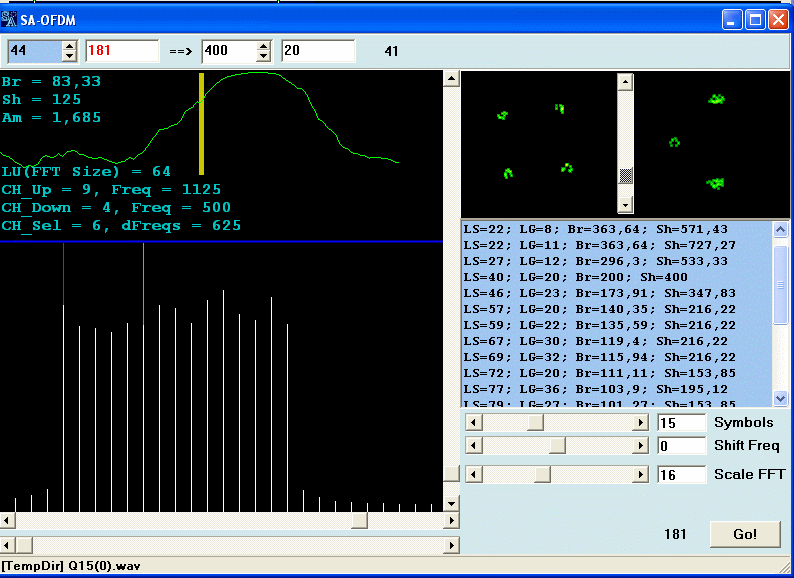
Now concerning the features of this record/signal. It's not possible to pass the fact, that the correlative triangle, which has been found by the program, actually, is similar to a triangle extremely poorly.
Moreover, if we will try to combine top of this triangle with the marker, (as you remember from article SA OFDM module, constellations in channels) thereby, selected best LU, the latest and the most reliable, we will not get good clear constellation. This signal, has acceptable by quality LU, for some reason occupy rather small part of the left slope of the triangle, while the record parameters precisely correspond to "native" ones, isn't it a mystery? In article “SA OFDM module. Constellations in channels”, everything has been described and convincingly told about about nuances of OFDM, and here, we have the signal, which refuses to behave normally? What is the problem and why it happens?
The problem is that this signal is cut off, and it is cut off very bad, by the rectangular bandpass filter, and it is absolutely useless.
Important:
- do not "decorate" records
- do not try to give "glamorous" look to record
- do not edit records by any way
It is known that, there is a sharp change of parameters of channels on junctions of OFDM symbols, the phase and/or amplitude varies. It naturally leads to appearance of out-of-band ejections, suppression of these ejections lead to same situation, as we have with this signal.
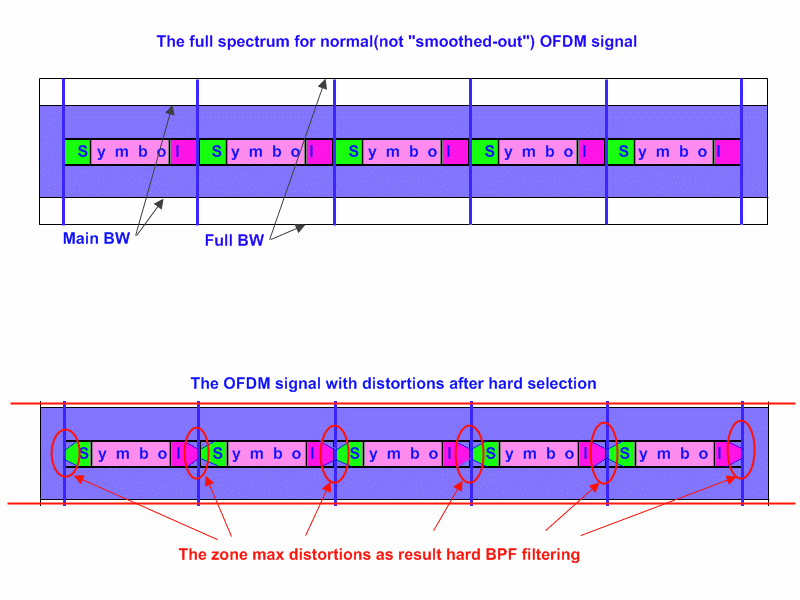
It is simple to see that such edition of the signal sharply reduces signal's noise stability. The demodulator will probably find acceptable LU for demodulation, but it will be not the best choice, and to tell honestly - it is deliberated distortion of the signal.
For analysis, it is always best do not do anything with the signal/record and leave it in initial condition.
Good Luck~
|
|
|
|
Добавлять комментарии могут только зарегистрированные, активировавшие регистрацию и не ограниченные в доступе участники сайта!
|
| Файл создан: 22 Dec 2009 21:48, посл. исправление: 22 Dec 2009 23:26 |
|

